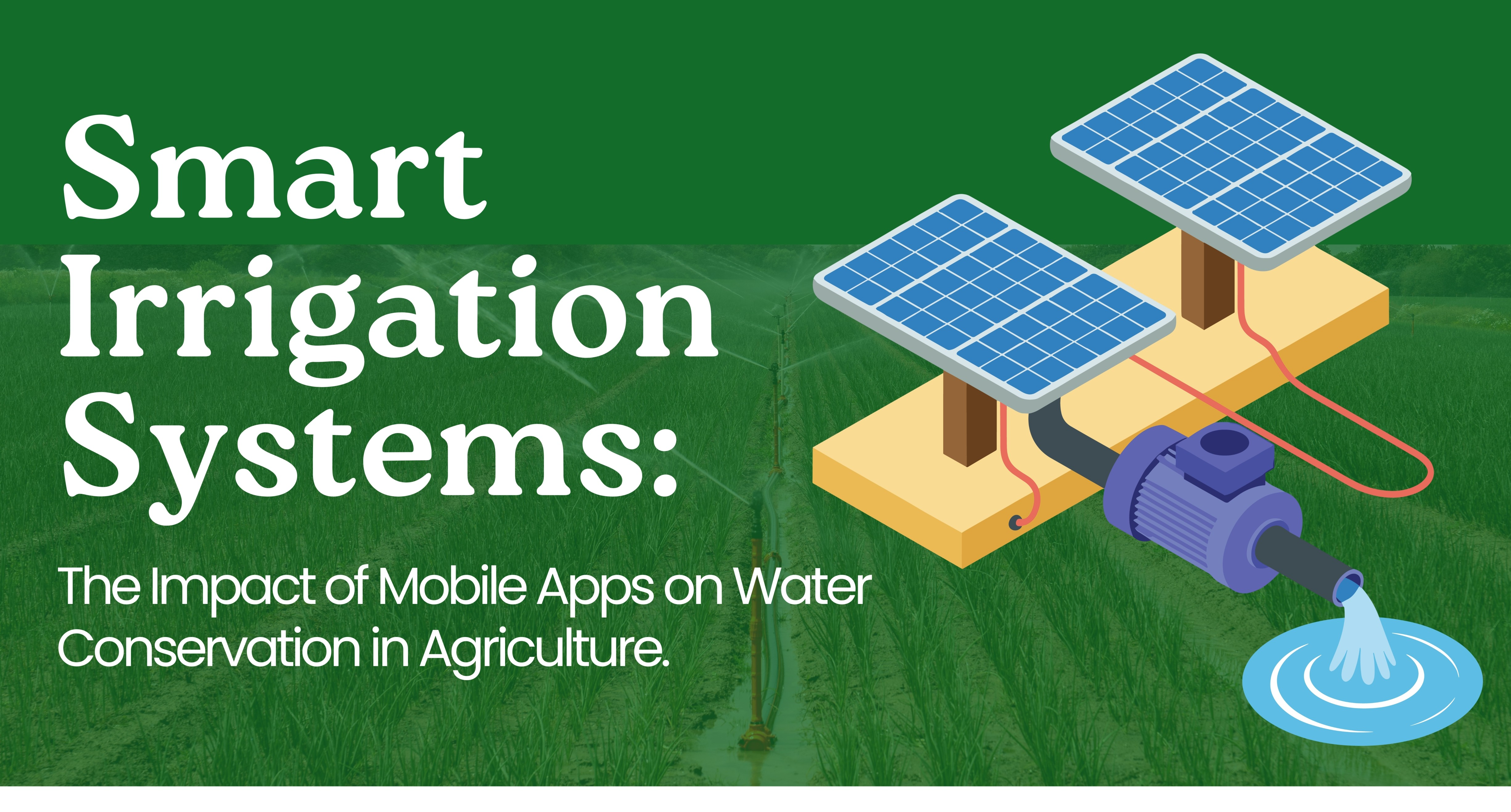Smart Irrigation Systems: The Impact of Mobile Apps on Water Conservation in Agriculture
Because the farming sector is so crucial, it needs constant innovations since it faces issues brought by climate change, an expanding population, and a shrinking supply of resources. An important example of advancement in this area is smart irrigation, which relies on mobile apps to support proper water usage and help make farming more sustainable! This is a core focus for modern Agritech Apps development. We will discuss in this blog how apps support farmers with water conservation.
The Water Crisis in Agriculture
Agriculture withdraws 70% of all the freshwater consumed around the world. As people continue to add to the population around the globe, a greater need for food will strain our existing water supplies. According to estimates, approaching half of the water used for irrigation is wasted because of evaporation, runoff, and applications that are not efficient.
At this moment, making irrigation more efficient has become absolutely necessary. Entering smart irrigation systems means using advanced technologies to save water, reduce waste, and ensure farmers practice sustainable methods. This shift is driving demand for specialized IT Services For agri-tech.
What Are Smart Irrigation Systems?
Smart Irrigation systems make use of sensors, climate monitoring, and applications on smartphones to help manage how much water is used in farming. They help farmers watch soil moisture, check on the weather, and learn about important crop needs in real-time to decide how to irrigate. Mobile App Development is central to these systems, allowing farmers to easily handle and watch their irrigation from afar. Using data from different spots, these programs allow farmers to set the best times to irrigate their fields.
The Role of Mobile Apps in Smart Irrigation
Mobile App Development is completely changing the ways farmers look at irrigation and manage their systems. Given below are the key features and benefits of these applications:
1. Real-Time Monitoring
Mobile apps help farmers monitor the level of moisture in their soil, the weather, and how healthy their crops are all at the same time. By using data, farmers can schedule irrigation just when needed, cut wasteful use of water and support the development of their crops. Forecasting rain enables farmers to hold off on watering and save both water and the soil from getting too wet.
2. Automated Irrigation Scheduling
Many irrigation systems allow farmers to set their schedules automatically using live information from the system. Now, if it’s raining or the soil is already moist, your app will adjust the watering times and lengths on its own. Having drip irrigation means less work and that the crops are well watered at all times.
3. Data Analytics and Insights
Many mobile apps include tools that give farmers a better understanding of their watering routine. By studying past records on water, yield, and the climate, farmers learn about possible changes in their environment and decide how best to water their crops. With data, farmers can manage water better and increasethe productivity of their farms.
4. Remote Control and Alerts
With remote control through mobile apps, farmers can manage their farms from any place. It is most useful for those farmers who have extensive farms or find it hard to be there all the time. Many app users receive alerts and notifications for important things, including issues with soil drying out or if equipment malfunctions, quickly allowing farmers to react.
Case Studies: Successful Implementations
Some companies have already started showcasing their potential for water conservation in agriculture, thereby implementing smart irrigation systems with mobile apps. The success of this implementation relies on robust IT Services For agri-tech solutions. They are:
1. CropX
CropX helps farmers by offering smart irrigation solutions based on soil sensors and an app. Farmers using the system get real-time soil moisture information and suitable irrigation advice matched to what they are growing and where they are located. Interviewing California farmers, it was found that CropX users were able to save 20-30% of their water while gaining similar or better crop yields. The results show that smart irrigation helps farmers save water without reducing their crop yields.
2. Rachio
Rachio is an irrigation controller that uses a mobile app so users can control how their systems work. While told to be used in the home, Rachio’s technology is now used at small farms and community gardens. The app, using actual weather data, sets the watering time so there is far less water usage than with manual timers. The community garden in Denver, where Rachio was used, saw a drop in water usage of up to 50%.
3. Irrigation Management Systems (IMS)
IMS combines different technologies such as soil moisture sensors, weather stations, and various mobile apps to help farmers manage irrigation better. Farmers using IMS in a pilot project in Texas found they saved 40% on water use and saw their crops grow healthier and produce more. Farmers could make better choices about water because the platform made valuable data available in real time. Smart Irrigation Systems helped conserve water greatly while farming, in this case.
The Environmental Impact of Smart Irrigation
Smart irrigation systems do more than help farms; they promote environmental protection in the community. When wastewater systems use water carefully, they lessen the challenge of water supply in regions that do not have much water. This is a key benefit derived from advanced Agritech Apps development.
1. Less water goes to waste when solar energy is used.
Traditional methods for irrigating leave crops lacking in water due to large evaporation and runoff. They lessen this problem by giving plants only the water they need, right in their roots. Mindful usage of water causes the soil to stay healthier, thereby avoiding over-saturation and erosion!
2. Progress in Soil Health
Correctly using data-based decisions for watering their crops helps farmers ensure the soil retains the correct amount of moisture, necessary for healthy planting. Properly fertilized soil keeps nutrients close and encourages helpful microorganisms, which leads to better crop harvests and the use of less chemical fertilizer. Adoption of this method helps sustain the environment as well as the amount of food produced!
3. Attempting to Control Climate Change
The way water is used in agriculture greatly increases greenhouse gas emissions. Smart irrigation systems help farmers reduce their usage of energy. Using water efficiently lowers how much of energy needed to move water, which means there are fewer emissions. Besides, crops that are raised more healthily can keep more carbon from entering the environment, aiding in fighting climate change.
Challenges and Considerations
While one side of the coin is the benefits of smart irrigation systems, the other side is the challenges, like:
1. Initial Costs
For some farmers, especially those who operate on a limited scale, paying for smart irrigation technology upfront is a problem. Still, you need to understand that this is an investment you can’t expect results from right away. Lower costs for water, higher yields, and lower requirements for labor will indirectly help pay for the initial expenses gradually. A number of governments and organizations distribute grants and subsidies to help farmers purchase these technologies.
2. Technical Literacy
Some rural farmers may find it hard to get used to smart irrigation at first. Help and training are necessary to teach farmers how to make the most of these technologies. The design of mobile apps should be simple and they should offer learning tools to users so they can gauge and act on the data correctly.
3. Data Privacy
Any time information is being collected using technology, issues related to privacy and security can come up. Protecting and using their data responsibly is something farmers must trust in. Firms in the smart irrigation field must focus on keeping user data safe and clear about their practices to gain customer trust.
The Future of Smart Irrigation
Because of recent advancements in technology and more people focusing on saving water, future smart irrigation systems will be promising. If more farmers use these methods, we should notice a move toward sustainable agriculture.
1. Integration with Other Technologies
When smart irrigation systems are used together with drones and agriculture technologies, they will work more effectively. Aerial drones can check crop health, and accurate farming tools can measure what’s going on below the soil. When we add smart irrigation to these technologies, we will have a better way to manage farms.
2. More Organizations Use AI and Machine Learning
The use of AI and machine learning is set to strongly influence how smart irrigation systems evolve. These tools gather various information related to the environment, crops, soil conditions and recent weather to correctly calculate how much water is needed. Because AI is being used more in smart irrigation systems, farmers will enjoy more accurate and efficient water usage.
3. Global Impact
The world needs to use smart irrigation systems to support sustainable agriculture in light of climate change and a lack of water. They are valuable for countries experiencing a lack of fresh water, since they keep food available while using less water.
Conclusion
Mobile app features on irrigation systems are helping to save water and make farming more ecologically friendly. Through access to live information, automation, and sophisticated analytics, the systems allow farmers to choose the best ways to use water and boost the health of their crops.
While introducing smart irrigation systems to many farmers might face obstacles, the benefits for farming, our environment, and future populations are huge. Adopting fresh thinking and highlighting sustainability allows us to grow a more flexible farm sector for upcoming challenges.









